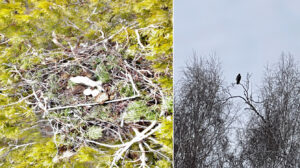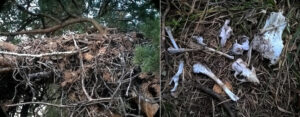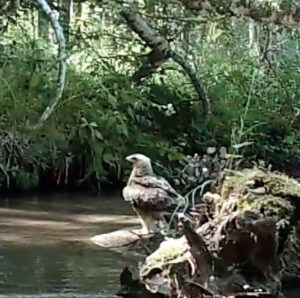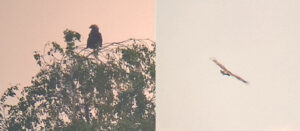Third International Scientific and Practical Conference “Eagles of the Palearctic: Study and Conservation”
Raptors Conservation. Suppl. 2. Proceedings of Conferences
Eagles in the Burabay State National Natural Park
Arkhipov Y. (Burabay State National Natural Park, Borovoe, Kazakhstan)
Becker J. (State Office for the Environment – State Bird Conservation Center Baitz, Germany)
Contact:
Yevgeniy Arkhipov arhipov.forestfires@mail.ru
Janosch Becker Janosch.Becker@LfU.Brandenburg.de
Recommended citation: Arkhipov Y., Becker J. Eagles in the Burabay State National Natural Park. – Raptors Conservation. 2023. S2: 153–156 DOI: 10.19074/1814-8654-2023- 2-153-156 URL: http://rrrcn.ru/en/archives/34929
From August 20 to September 17, 2022 and in the spring of 2023, the authors conducted ornithological research in the State National Natural Park “Burabay”. In the course of the research, information was obtained on encounters with eagles in the territory of the park.
Imperial Eagles (Aquila heliaca) ) were observed throughout the area on a daily basis. A total of 44 observations were recorded during the research period, some of which were definitely migrants rather than local breeding birds. Only four out of 44 individuals observed were this year's birds. To the northeast of Big Chebachee Lake on 14/09/2022, adult birds were feeding a nestling, indicating the presence of a breeding territory of eagles here. In April 2023, a nest with two eggs was found (Fig. 1).
A large eagle nest, presumably of the Golden Eagle (Aquila chrysaetos), was found in the forest north of Zhukey Lake in the 40 district on September 6, 2022. The nest was located on an old pine tree and was approximately 1.5 m in diameter. Bone remains of prey and feathers of various birds of prey (e.g. Buzzards Buteo buteo) were found under the nest (Fig. 2). Shortly afterwards, an eagle, identified by us as this year's Golden Eagle, was seen in the vicinity of the nest, and on 13/09/2022 an adult bird was observed between the lakes Maloye Chebachee and Bolshoye Chebachee, north of Lake Maibalyk.
An adult Greater Spotted Eagle (Aquila [Clanga] clanga) was observed near the Kairaktin Forest District on 26/08/2022. The bird was carrying food in its beak to a juvenile bird calling from the forest (Becker/ebird.org; Wassink, 2023). This is the first case of breeding of the Greater Spotted Eagle in the State National Natural Park "Burabay". Another juvenile bird, uncertainly identified as the Great Spotted Eagle, was seen a few hours later about 12 km south of the previous encounter site (Fig. 3).

Fig. 1. Nest of the Imperial Eagle (Aquila heliaca) and an adult bird near the nest. Photos by Y. Arkhipov.

Fig. 2. Nest and food remains, presumably of a Golden Eagle (Aquila chrysaetos). Photos by J. Becker.

Fig. 4. Booted Eagle (Hieraaetus pennatus), 21 July 2021. Photo by Y. Arkhipov (from Wassink, 2023).
Steppe Eagle (Aquila nipalensis) was observed twice, once on 25/08/2022 in Saule aul and once on 05/09/2022 over Ulkensor Lake. Steppe eagles are likely to be migrants or nomads within the Park after the breeding season, but do not breed in the Park.
The Booted Eagle (Hieraaetus pennatus) was observed four times, on August 22 and 23 in the territory of Barmashinskoye Forestry, and on September 8 and 15, 2022 in the vicinity of Borovskoye Forestry, with birds of both light and dark morphs (Becker/ebird.org).
In addition, on 21/07/2021, the Booted Eagle was recorded by a trap camera set up in the forest between Burabay and Sarybulak (Fig. 4) (Wassink, 2023). The nearest known breeding territory is located approximately 430 km to the southeast in Bayanaul National Park (Reznichenko, 2012; 2020).
Proposed measures for the conservation of the considered bird species on the territory of the State National Natural Park "Burabay":
- introduce a ban on any logging within a radius of 1.5 km from eagle breeding territories;
- sanitation cutting, with mandatory reforestation of native tree species, only after nestlings have learned to fly;
- limit the presence of livestock and people within 500 m of eagle nests during the breeding season;
- during the incubation period and before fledglings take wing, inspectors should conduct daily rounds of the breeding areas (within 500 meters of the nests) to prevent possible violations by park visitors;
- restrict watering of livestock on the banks of water bodies near eagles' nests.

